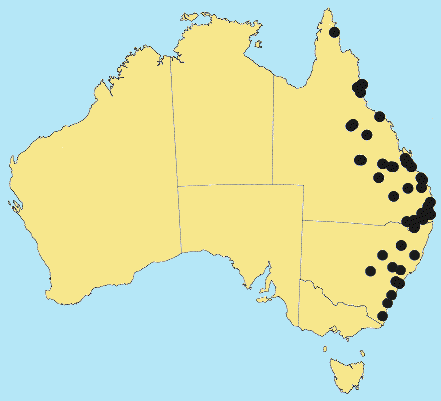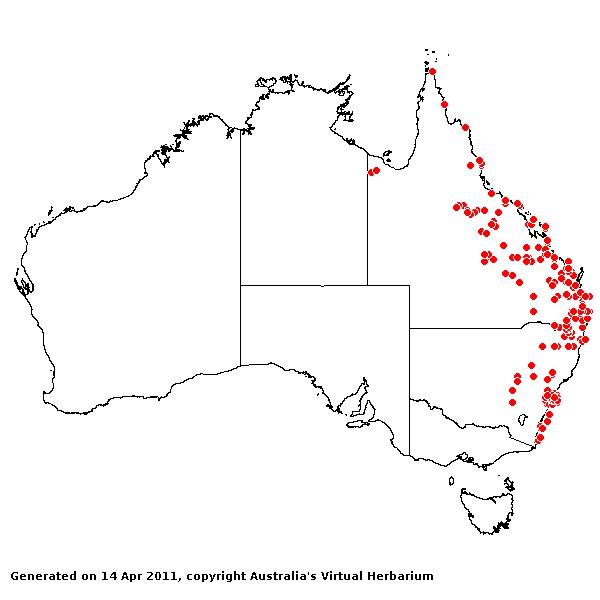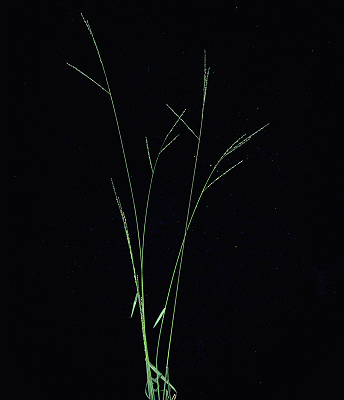Digitaria ramularis (Trin.) Henrard. Blumea 1: 101 (1934).
Classification. (GPWG 2001) : Subfamily Panicoideae. Paniceae.
Basionym and/or Replacement Name: Panicum ramulare Trin., Gram. Panic. 244 (1826).
Type of Basionym or Protologue Information: HT: Lindley s.n, Nov.Holl[andia]: ad portum GacksJon (LE-TRIN-0919.01).
Recent synonyms: D. tenuissima.
Key references (books and floras): [1878] G.Bentham, Flora Australiensis 7 (470 as Panicum tenuissimum), [2002] D.Sharp & B.K.Simon, AusGrass, Grasses of Australia, [2008] S.W.L.Jacobs, R.D.B.Walley & D.J.B.Wheeler, Grasses of New South Wales (220).
Illustrations: [2008] S.W.L.Jacobs, R.D.B.Whalley & D.J.B.Wheeler, Grasses of New South Wales, 4th edn (220).
Habit. Perennial. Rhizomes present. Stolons absent. Culms erect or geniculately ascending, 30–90 cm tall, 3–7(–11) -noded. Mid-culm internodes glabrous. Mid-culm nodes glabrous or pubescent. Lateral branches simple or sparsely branched. Leaf-sheaths glabrous on surface or hairy. Leaf-sheath auricles absent. Ligule an eciliate membrane, 2–4 mm long, truncate or obtuse. Leaf-blades flat, 5–25 cm long, 1.1–5.5 mm wide. Leaf-blade surface scabrous, glabrous or indumented.
Inflorescence. Inflorescence compound, a panicle of racemes. Racemes 2–10, spreading, flexuous, 3–13 cm long. Central inflorescence axis 1.5–10 cm long.
Spikelets. Spikelets pedicelled, 2 in the cluster. Fertile spikelets 2-flowered, the lower floret barren (rarely male), the upper fertile, comprising 1 basal sterile florets, comprising 1 fertile floret(s), without rachilla extension, oblong, dorsally compressed, 1.5–2 mm long. Rhachilla internodes brief up to lowest fertile floret.
Glumes. Glumes thinner than fertile lemma. Lower glume ovate, membranous. Upper glume elliptic, 1.1–1.8 mm long, membranous, without keels, 3 -nerved. Upper glume surface glabrous or indumented. Florets. Basal sterile florets 1, barren, without significant palea. Lemma of lower sterile floret 90–100 % of length of spikelet, membranous, 5–7 -nerved.
Fertile lemma 1.4–2 mm long, without keel. Lodicules present.
Continental Distribution: Australasia.
Australian Distribution: Queensland, New South Wales.
Queensland: Burnett, Cook, Darling Downs, Leichhardt, Mitchell, Moreton, North Kennedy, Port Curtis, South Kennedy, Wide Bay, Burke, Maranoa. New South Wales: North Coast, Central Coast, South Coast, Central Tablelands, North-Western Slopes, Central-Western Slopes.
Notes. Closely related to D. parviflora and D. breviglumis.
In tropical and subtropical wet sclerophyll forests, dry sclerophyll forests, tropical and subtropical sub-humid woodlands, and temperate sub-humid woodlands. Flowers mostly Feb.-June.




